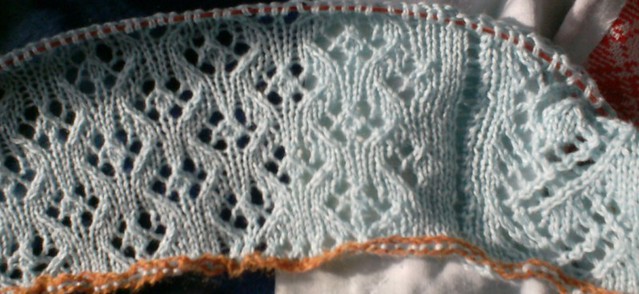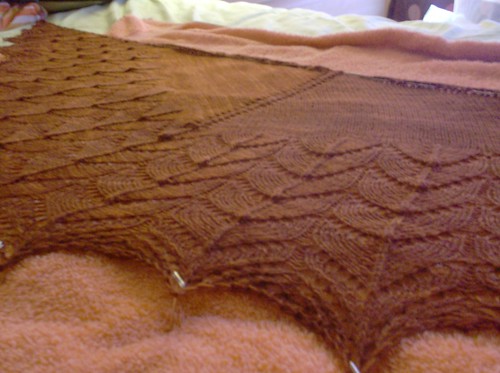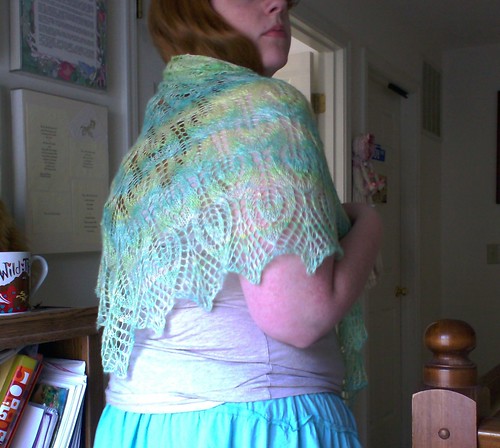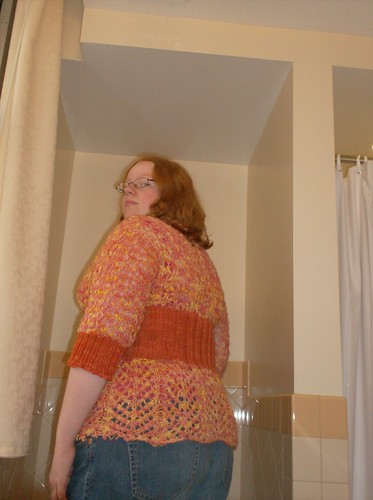One of my top search engine terms, month after month, has been along the lines of 'what is the fiber content of lace', 'lace fiber content', 'fiber content of silk'... I'm not sure exactly why I'm getting so many hits on these terms, but I thought I'd write a little about it so if people find my blog, they'll find what they're looking for. :)

First of all, knitted lace is a very wide field. The definition of knitted lace is knitting that has holes in it. Some people consider knitting that has holes in only every other row (ie, every right side row) to not be 'true' lace, but considering the vast majority of lace patterns have plain wrong side rows, we will simply work with the definition of lace knitting as knitting with holes in.
Lace can be knitted in any weight of yarn, and any needle size. The yarn and needle choice will change the character of the lace - You can knit a lace afghan in worsted weight yarn, and it will be warm and heavy, but if you knit the same pattern in laceweight yarn, you would have a delicate shawl.

A lace pattern on a bulky weight jumper.

That same lace motif on a fingering-weight shawl.
The needle size will also affect your lace, in relation to the size of the yarn you use. Lace can be knit tightly or loosely, for different effects. You can see some lace swatch needle size comparisons here and here.
One could write a whole book on lace knitting, easily - but, I digress. In essence, lace can be knit in any yarn and needle size, in a variety of ways, but every change affects the finished fabric. Most commonly, lace is knitted in lightweight (fingering or lace weight) yarn with a relatively large needle size, for a drapey finished result.
The fiber content of your yarn will also affect your resulting item. Alpaca, silk, or bamboo in a yarn will give it drape. Wool will give it memory. Mohair or alpaca will give it halo. All of these are just fine, and it will depend on what you want the finished item to look like - if you value the stitch definition above all, go for a smooth yarn instead of a fuzzy one. If you want your shawl to really fall over you, go for a drapey yarn with silk or alpaca. Maybe you want something shiny - silk, bamboo, or tencel will give the yarn sheen.

Silk is extremely drapey, soft, and shiny, and is a great choice for luxurious drapey shawls.

Wool is very elastic and will hold its shape where other fibers might sag and stretch.
Just about the only yarn that is completely unsuitable for lace is a yarn which is entirely synthetic - think acrylic or nylon. Acrylic just doesn't hold a block - that is, when you finish your lace item, you wash it and then pin it out to allow the yarnovers to open up. On the needles, lace often looks bumpy and sad. Blocking stretches it out. Animal fibers block extremely well, but synthetic fibers don't block at all.

A handspun silk shawl before blocking...

...and after blocking.
So in conclusion, you can just just about any yarn for lace - just keep in mind the properties of the yarn, which will directly affect the properties of your finished item. Once you learn a little bit about the characteristics of different fibers, you will get a sense of what kinds of fibers or fiber blends will work well in what project. Of course, it's possible to knit a ribbed cardigan out of bamboo, or a lace shawl in Red Heart - it just may not be advisable. As knitters, we have complete freedom to choose the characteristics of our FOs, by choosing the yarn, choosing the needle and the sizing, making modifications -- sometimes our mods don't work out for the best, but it's a learning experience. :)
~Joyuna

 The Grateful Crane Shawl
The Grateful Crane Shawl Elven Slippers
Elven Slippers Russell Square Mitts
Russell Square Mitts Russell Square Tam
Russell Square Tam iTouch Jumper
iTouch Jumper Twisty Wristband
Twisty Wristband Mawata Pulsewarmers
Mawata Pulsewarmers
No comments:
Post a Comment